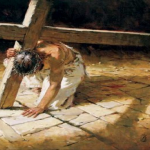Sample Lesson Plan
Click here to download the SEE lesson planning template.
Learning Activities
The following is a suggestive list of exercises that facilitate conversion of the imagination when utilized within the SEE process. The teacher’s approach and the pedagogical process are essential for the effectiveness of these exercises. Refer to Converting the Imagination for detailed guidance.
Exercises for Stimulating the Imagination (Movement 1)
The aim of these exercises is to elicit learners’ interest and activate their thinking at the level of the imagination where deep meaning is generated.
- Discussion of existential questions such as: What makes for a good life? What is most important in life? Who am I? Why is there so much suffering in the world? How do we deal with the suffering we encounter? How do we live together?
- Discussion of current events or students’ experiences that raise such existential questions.
- Taking a field trip to a place or event that raises such questions or generates a particular kind of experience (e.g., a theatrical performance, a Holocaust memorial, a homeless shelter).
- Viewing videos or listening to music that raises such questions and generate discussion about matters of vital importance (e.g., these commercials).
- Exploring images and artwork that treat themes of existential import
- Reading or sharing stories that evoke themes of vital importance (see Paul Lakeland’s The Wounded Angel for literary examples).
- Learners producing their own art, stories, music, presentations, or skits in order to give expression to their burning questions, formative experiences, and ways of seeing things (e.g., as in the Bibliodrama approach or this approach to Drawing God).
- Concept mapping as a means for learners to mirror back to themselves the symbol system that structures their worldview.
Exercises for Expanding the Imagination (Movement 2)
The double aim of these exercises is to expose limitations in learners’ current way of seeing things and give them access to more adequate, more adaptive sources of meaning and ways of imagining.
- Questioning and/or activities that problematize or expose limits in learners’ current manner of constructing meaning (e.g., questions like “What effect does this way of seeing things have on your behavior and relationships?” “Why do other people see things differently?” “What would life be like if you looked at the matter differently?”).
- Exploring key symbols, stories, practices, and teachings from the Christian tradition that potentially offer greater depth of meaning and coherence. This exploration might take the form of:
- Reflecting on Scripture, ideally in a slow, contemplative manner. Some ways of doing this include:
- following the steps of lectio divina
- using the Ignatian method of “composition of place”
- meditating on Scripture through doodling and coloring, as recommended by Visual Faith Ministry
- Jesus’ parables are especially conducive to expanding and transforming our way of seeing things. See also these wonderful modern parables based on the Beatitudes and the author’s guidelines for engaging them.
- These videos from the Bible Project are an engaging way to draw learners (especially young ones) into the stories of Scripture.
- Reading fictional works and films rooted in the Christian imagination (e.g., the writings of J. R. R. Tolkien, C. S. Lewis, Flannery O’Connor, or Graham Greene).
- Exploring Christian art and music
- Participating in prayer or a liturgical experience
- A field trip or new experience
- A presentation by an expert on some aspect of the Christian tradition (either in person or via a video conferencing platform like Zoom)
- Reflecting on Scripture, ideally in a slow, contemplative manner. Some ways of doing this include:
Exercises for Embracing New Ways of Imagining (Movement 3)
The aim of these exercises is for learners’ to appropriate for themselves more adequate sources of meaning and ways of imagining.
- Critical questioning and discussion of the images, meanings, and teachings explored in Movements 1 and 2. Questions for discussion might include: “Who crafted these images, and why?” “What values and assumptions are baked into these images?” “What effect do these images have on my sense of identity, behavior, and relationships?” “Do they help me make sense of my experiences?” “Do they make life seem more meaningful?”
- Reflecting on learners’ judgments through lecture, discussion, and/or writing. This might involve learners making explicit the criteria by which they judge the value of images, teachings, etc. and discussing which criteria are most appropriate and why.
- Making personal judgments in writing or in conversation about the adequacy of learners’ orienting symbols and those of the Christian tradition.
- Synthesizing a personal vision for life, work, relationships, etc. by means of discussion, writing exercises (e.g., writing a personal creed or plan), or artistic expression and projects (e.g., painting or creating a Prezi).
- Making decisions about and for learners’ lives based on these judgments through individual writing or perhaps a group ritual. Teachers might suggest to learners concrete implications of living out particular judgments or invite them to brainstorm specific ways they will follow through on their decisions.
- Enacting decisions through rituals, service, or other applied projects.

